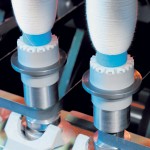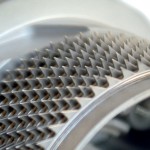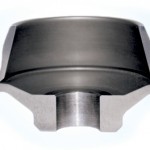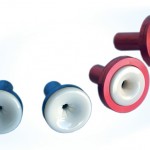By Hans Speich and Jörg Feigl, Rieter Spinning Systems
 In these fast-moving times, parts or components are rapidly super
In these fast-moving times, parts or components are rapidly super seded and replaced by more up-to-date solutions. In these cases it is crucial to make a timely change to the new solution. This prevents unforeseen and prolonged production losses. Rieter cautions its customers in time and offers appropriate products.
seded and replaced by more up-to-date solutions. In these cases it is crucial to make a timely change to the new solution. This prevents unforeseen and prolonged production losses. Rieter cautions its customers in time and offers appropriate products.
In addition to the new machinery business, Rieter devotes considerable attention to further developments of earlier generations of machinery. Productivity, quality and running behavior as well as user-friendliness and economic efficiency are thus decisively improved.

Development in textile machinery manufacturing is very rapid: parts or components have to be replaced and superseded promptly for more up-to-date solutions in order to avoid unforeseen and prolonged losses of production. Quality, process optimization and cost savings are major factors for remaining competitive. With conversion kits, new technology components and retrofits, Rieter offers customers the opportunity to adapt their machinery portfolio continuously and update it to the latest state-of-the-art (Fig.1). Continuous information gives customers the assurance of producing yarn of the best possible quality.
Operating reliability, increased output
Higher output also increases the strain on certain machine components. If this is disregarded, the result is increased wear and higher operating costs. At the same time, the strain imposed, for example, by an emergency stop can result in unnecessarily high stresses and ultimately in greater wear on the equipment. However, there is a reliable, correct solution to every problem. Here are a few examples:
XR coating on Rieter opening rollers

“XR” stands for ‘Extra Resistant’. This Extra is achieved by the application of nano-structured layers to the opening rollers (Fig.2). Wear tests on opening rollers with DN coating clearly demonstrated the problems that occur when processing sensitive polyester (PE) fibers: as soon as the nickel layer of the DN coating has been worn off to a certain extent and the relatively rough diamond coating emerges on the surface, the opening rollers become unusable.
The rough surface results in a deterioration in running properties, the generation of more dust in the spinning process, and greater fiber damage. This can lead to higher staff values and dust generation problems in downstream processing. The DN-coated opening rollers therefore have to be replaced when the nickel layer has worn off, although the diamond coating is not worn.
The XR coating has been developed to deal with this problem. Its characteristic feature is extreme wear resistance due to its very high hardness and the nano-structured composition of its coating layers. A special surface finish makes its surface roughness comparable to that of an uncoated set of clothing. The very smooth, fiber-preserving surface characteristic remains intact throughout its service life, thanks to the homogeneous coating structure. This guarantees uniform spinning conditions.
Uniform quality

For rotors, “RD” stands for “Rieter Diamond” and refers to a patented RD coating which is offered for rotors exclusively by Rieter (Fig.3). The systematic structure of the multi-layer diamond coating produces different surface structures on the rotor wall and in the rotor groove. This is not only ideal for the spinning process; the intelligent structure of the diamond layers guarantees at least the same service life as a BD coating. The RD coating also guarantees constant technological values throughout its entire service life. The fields of application of the new coating are the same as those for BD coating. This innovative manufacturing process enables the RD rotor to be offered at a lower price than the BD rotor.

Spinning stability and yarn characteristics, which are essentially defined by hairiness, can be extensively influenced by selective design of the draw-off nozzle. It is well known that making notches in the nozzle funnel is an extremely effective means of achieving this. Hairiness and spinning stability depend on the number, size, shape and position of the notches and the co-ordination of these parameters with the radius of the funnel and the grip of the surface, i.e., the co-efficient of friction with the yarn. The “nano6” and “nano8” draw-off nozzles represent the ideal co-ordination of these multi-dimensional parameters, aimed at systematic further development for the given application (Fig.4).
Further development to the “neXT Generation” is rounded off by optimized materials application and production technology. The materials application technology used, with the resulting surface structure, enables wear to be reduced and fiber damage to be minimized on both draw-off nozzles at maximum productivity. The production technology with minimal tolerances guarantees reproducible, top-level quality.